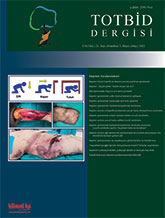
Extremity injuries are among significant causes of morbidity following earthquakes. The benefits of limb salvage in disaster settings are greater as the economic and human impact of limb loss can be worse. Many factors such as the general condition of the patient, the degree of vascular, nerve, bone, and soft tissue injury, the degree of contamination, the patient`s psychological status, expectations and comorbidities, the availability of resources and experience for reconstruction team should be taken into account in the decision-making process for the treatment of mangled extremity injuries after an earthquake. In appropriately selected patients, limb salvage is more advantageous than amputation. Since the priority is to save a life, limb salvage may be contraindicated in polytrauma patients or in hemodynamically unstable patients. While scoring systems can be safely used in the decision of limb salvage due to their high specificity, these systems are not sufficient to guide amputation decisions due to their low sensitivity. It becomes much more important to make decisions, especially during natural disasters, such as earthquakes, where there is a large number of patients. For this reason, the decision to limb salvage or amputation should be made with an experienced team. Preoperatively, patients and their families should be well informed about the process and possible results.